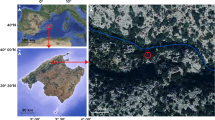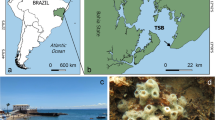Abstract
Massive specimens of Cliona viridis, collected off the coast of Blanes (North-Western Mediterranean Sea) in January 1987, were exposed to different light (natural day-night irradiance/constant darkness) and substrata (calcareous/siliceous) conditions to assess their influence on growth, survival and attachment rates. Sponges cultured under natural irradiance displayed higher growth rates with increasing temperature; those cultured in the dark did not respond to increased temperature, but adapted faster to laboratory conditions. Differences in growth rates between these two culture conditions are ascribed to the presence of a healthy symbiotical zooxanthellae population on individuals cultured under conditions of natural irradiance. Attachment rates of the cut sides of the sponges which were in direct contact with the substratum, also increased with increasing temperature, whilst sponge survival was not significantly dependent on temperature. The chemical nature of the substratum clearly affected survival rates, which were higher on calcified than on siliceous substrata.
Similar content being viewed by others
Literature cited
Amade, P., Charroin, G., Baby, C., Vacelet, J. (1987). Antimicrobial activities of marine sponges from the Mediterranean Sea. Mar. Biol. 94: 271–275
Ayling, A. M. (1981). The role of biological disturbance in temperate subtidal encrusting communities. Ecology 62: 830–847
Ayling, A. L. (1983). Growth and regeneration rates in thinly encrusting Demospongiae from temperate waters. Biol. Bull. mar. biol. Lab., Woods Hole 165: 343–352
Ballesteros, E. (1984). Els vegetals i la zonació litoral: espècies, comunitats i factors que influeixen en la seva distribució. Ph. D. thesis. University of Barcelona
Barthel, D. (1989). Growth of the sponge Halichondria panicea in the North Sea habitat. Proc. 21st Eur. mar. Biol. Symp. 23–30 [Klekowski, R. Z. et al. (eds.) Institute of Oceanology, Polish Academy of Sciences, Gdańsk]
Barthel, D., Theede, H. (1986). A new method for the culture of marine sponges and its application for experimental studies. Ophelia 25: 75–82
Bryan, P. G. (1973). Growth rate, toxicity and distribution of encrusting sponge Terpios sp. (Hadromerida: Suberitidae) in Guam, Marianas Islands. Micronesica 9: 237–242
Burkholder, P. R., Rützler, K. (1969) Antimicrobial activity of some marine sponges. Nature, Lond. 222: 983–984
Dayton, P. K. (1979). Observations on growth, dispersal and population dynamics of some sponges in McMurdo Sound, Antarctica. In: Levi, C., Boury-Esnault, N. (eds.) Biologie des spongiaires. Centre National de la Recherche Scientifique, Paris, p. 271–282
De Laubenfels, M. W. (1952). Life histories and longevity of Porifera. Vie Milieu 3: 386–388
Elvin, D. W. (1976). Seasonal growth and reproduction of an intertidal sponge Haliclona permollis (Bow.). Biol. Bull. mar. biol. Lab., Woods Hole 151: 108–125
Elvin, D. W. (1979). The relationships of seasonal changes in the biochemical components to the reproductive behavior of the intertidal sponge, Haliclona permollis. Biol. Bull. mar. biol. Lab., Woods Hole 156: 47–61
Fankboner, P. V., Reid, R. G. (1981). Mass expulsion of zooxanthellae by heat-stressed reef-corals: a source of food for giant clams? Experientia 37: 251–252
Fell, P. E., Lewandrowski, K. B. (1981). Population dynamics of the estuarine sponge, Halichondria sp., within a New England eelgrass community. J. exp. mar. Biol. Ecol. 55: 49–63
Fell, P. E., Parry, E. H., Balsamo, A. M. (1984). The life histories of sponges in the Mystic and Thames estuaries (Connecticut), with emphasis on larval settlement and postlarval reproduction. J. exp. mar. Biol. Ecol. 78: 127–141
Goreau, T. F. (1964). Mass expulsion of zooxanthellae from Jamaican reef communities after Hurricane Flora. Science, N. Y. 145: 383–386
Hartman, W. D. (1957). Ecological niche differentiation in the boring sponges (Clionidae). Evolution 11: 294–297
Hartman, W. D. (1958). Natural history of the marine sponges of Southern New England. Bull. Peabody Mus. nat. Hist. 12: 1–155
Hoppe, W. F. (1988). Growth, regeneration and predation in three species of large coral reef sponges. Mar. Ecol. Prog. Ser. 50: 117–125
Neumann, A. C. (1966). Observations on coastal erosion in Bermuda and measurements of the boring rate of the sponge, Cliona lampa. Limnol. Oceanogr. 11: 92–108
Nicol, W. L., Reisman, H. M. (1976). Ecology of the boring sponge (Cliona celata) at Gardiner's Island, New York. Chesapeake Sci. 17: 1–7
Pomponi, S. A. (1980). Cytological mechanisms of calcium carbonate excavation by boring sponges. Int. Rev. Cytol. 65: 301–319
Reimer, A. A. (1971). Observations on the relationships between several species of tropical zoanthids (Zoanthidea, Coelenterata) and their zooxanthellae. J. exp. mar. Biol. Ecol. 7: 207–214
Reiswig, H. M. (1973). Population dynamics of three Jamaican Demospongiae. Bull. mar. Sci. 23: 191–226
Rosell, D., Uriz, M. J. (1991). Cliona viridis (Schmidt, 1862) and Cliona nigricans (Schmidt, 1862) (Porifera, Hadromerida): evidence which shows they are the same species. Ophelia 33: 45–53
Rützler, K. (1970). Spatial competition among Porifera: solution by epizoism. Oecologia 5: 85–95
Rützler, K. (1975). The role of burrowing sponges in bioerosion. Oecologia 19: 203–216
Sarà, M. (1966). Associazioni fra Poriferi e alghe in acque superficiali del litorale marino. Ricerca scient. 36: 277–282
Sarà, M. (1970). Competition and cooperation in sponge populations. Symp. zool. Soc. Lond. 25: 273–284
Sarà, M. (1971). Ultrastructural aspects of the symbiosis between two species of the genus Aphanocapsa (Cyanophyceae) and Ircinia variabilis (Demospongiae). Mar. Biol. 11: 214–221
Sarà, M., Liaci, L. (1964). Symbiotic association between zooxanthellae and two marine sponges of the genus Cliona. Nature, Lond. p. 321
Simpson, T. L. (1963). The biology of the marine sponge Microciona prolifera (Ellis and Solander) I. A study of cellular function and differentiation. J. exp. Zool. 154: 135–147
Sokal, R. R., Rohlf, F. J. (1981). Biometry. The principles and practice of statistics in biological research. 2nd ed. W. H. Freeman & Co., New York
Storr, J. F. (1964). Ecology of the Gulf of Mexico commercial sponges and its relation to the fishery. Spec. scient. Rep. U.S. Fish Wildl. Serv. 466: 1–73
Taylor, D. L. (1969). On the regulation and maintenance of algal numbers in zooxanthellae-coelenterate symbiosis, with a note on the nutritional relationship in Anemonia sulcata. J. mar. biol. Ass. U.K. 49: 1057–1065
Taylor, F. J. R. (1987). Ecology of dinoflagellates. A. General and marine ecosystems. In: Taylor, F. J. R. (ed.) The biology of dinoflagellates. Blackwell Scientific Publications. Oxford, London, Edinburgh, Boston, Palo Alto, Melbourne, p. 399–502
Uriz, M. J., Martín, D., Rosell, D. (1992). Relationships of biological and taxonomic characteristics to chemically mediated bioactivity in Mediterranean littoral sponges. Mar. Biol. 18: 287–297
Uriz, M. J., Rosell, D., Martín, D. (1992). The sponge population of the Cabrera Archipelago (Balearic Islands): characteristics, distribution and abundance of the most representative species Pubbl. Staz. zool. Napoli (I: Mar. Ecol.) 13: 101–117
Vacelet, J. (1971). Etude en microscopie électronique de l'association entre une cyanophycée chroococcale et une éponge du genre Verongia. J. Microscopie 12: 363–380
Wilkinson, C. R. (1978). Microbial associations in sponges. I. Ecology, physiology and microbial population of coral reef sponges. Mar. Biol. 49: 161–167
Wilkinson, C. R., Cheshire, A. C. (1988). Growth rate of Jamaican coral reef sponges after Hurricane Allen. Biol. Bull. mar. biol. Lab., Woods Hole 175: 175–179
Wilkinson, C. R., Vacelet, J. (1979). Transplantation of marine sponges to different conditions of light and current. J. exp. mar. Biol. Ecol. 37: 91–104
Yonge, C. M., Nicholls, A. G. (1930). Studies on the physiology of corals. IV The structure, distribution and physiology of the zooxanthellae. Scient. Rep. Gt Barrier Reef Exped 1: 135–176
Author information
Authors and Affiliations
Additional information
Communicated by J. M. Pérès, Marseille
Rights and permissions
About this article
Cite this article
Rosell, D., Uriz, M.J. Do associated zooxanthellae and the nature of the substratum affect survival, attachment and growth of Cliona viridis (Porifera: Hadromerida)? An experimental approach. Marine Biology 114, 503–507 (1992). https://doi.org/10.1007/BF00350042
Accepted:
Issue Date:
DOI: https://doi.org/10.1007/BF00350042




